

home | books | treeblog | talks | walk of the month | walk directory | contact us

In St Albans, there are trees with fascinating historical connections that span two millennia. This walk takes us round some superb trees and tells the story of each of them.
I have chosen this walk for midsummer because leaves are full out and there is the chance of either flowers or fruit.
The walk takes us from the war memorial in St Albans City Centre, through the town centre and down to Verulamium Park.
2 miles at most.
The walk displayed here on the walk-talk Website has lots of photos, stories of the trees, links to further information as well as directions (in bold) so that you can take a virtual walk - you can enjoy imagining the walk.
To do the walk in reality, use the print options below to give yourself the level of detail and photographs that you want. The documents are in MS Word format so that you can add your own notes and delete what you do not want before printing.
To print, click: short directions | directions with photos
Also, a summary leaflet with map "St Albans Heritage Tree Trail" is available for £1 at the Museums and The Tourist and Information Centre, the Inn on the Park, The White Hart Hotel on Holywell Hill, The Lower Red Lion in Fishpool Street, The Comfort Hotel on Holywell Hill and various other community-minded local outlets.

There is parking in ticketed car parks in Drovers Way, close to St Peter's church. Parking there is free on Sundays.
Refreshments can be found hard by the war memorial in The Blacksmiths Arms and across the road in The Cock. At the other end of the walk, the Inn on the Park which is close to the end of the walk, The Six Bells and The Rose and Crown in St Michaels village and the Black Lion and The Blue Anchor at the bottom of Fishpool Street do the same. On the route back up to Town, there is the Lower Red Lion higher up Fishpool Street or the Abbey Refectory and there are numerous cafes and pubs and eating places in the centre.
Toilets are adjacent to Verulamium Museum, close to the South door of the Abbey and at the far end of The Maltings in Chequer Street.
The walk starts at the war memorial,

takes us into St Peter's churchyard,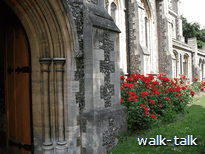
behind and then into St Peter's Street,

along
French Row,

through Wax House Gate,

to the
Vintry Gardens,

behind the Abbey,
the Abbey,
into Abbey Orchard .
.
out into the little crescent at the bottom of
Holywell Hill,

through Westminster Lodge
 and Verulamium Park.
and Verulamium Park.

BRIEF DIRECTIONS
Please let me know of any other trees whose connections ought to be known.
FULL DESCRIPTION
A walnut tree was planted in St Peter’s churchyard to commemorate an early carer of sufferers from mental illness, Nathaniel Cotton, who is buried in St Peter’s churchyard.
From St Albans elegant art nouveau war
memorial,
 we turn our backs on the city centre and walk towards St Peter's
church. The memorial gardens are on our left and the row of old sand-dashed cottages are on our right.
we turn our backs on the city centre and walk towards St Peter's
church. The memorial gardens are on our left and the row of old sand-dashed cottages are on our right.
We enter St Peter's churchyard
 and turn right along
the path leaving the church on our left
and turn right along
the path leaving the church on our left
and then a grassy car park on our right.
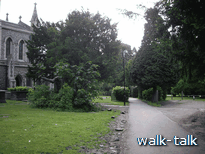 We are walking along the south side of the church.
We are walking along the south side of the church.
When we reach the end of the church, the south east corner,
we see three grave stones laid flat on the earth.

The centre grave is that of Nathaniel Cotton and his wife Ann
Hannah.

NATHANIEL COTTON founded an asylum for the insane in St
Albans in the 1730s. I do not know where the asylum was first housed, but in
1760 Cotton moved the
institution to what is now Lower Dagnall Street. The asylum was called the
Collegium
Insanorum
– hence College Street.

The building was not demolished until 1930.
Cotton's most famous patient was William Cowper (1731-1800) the poet. Cowper (pronounced Cooper) was brought to Cotton's asylum to be 'cured of his madness' in December 1763 and stayed there until June 1765.
William Cowper had moved to the Buckinghamshire village of Olney at the instigation of John Newton who was curate there. John Newton was an extraordinary man who had been converted to evangelical Christianity after being a captain of a slave ship. Together, Cowper and Newton wrote the Olney Hymns, one of which is the enduring Amazing Grace.
Cowper suffered extreme depression and was fortunate to come to Nathaniel Cotton. Cotton was a forward-thinking practitioner and encouraged his patients to talk through their problems. He also encouraged his patients to walk and it is said that Cowper was to be seen walk, walk, walking the streets of St Albans, carrying a lantern if it was after dark.
We can read the words cut into Nathaniel Cotton's grave stone: “Here are deposited the remains of Ann Hannah and Nathaniel Cotton” but some sources say that Cotton was buried with both his wives. Cotton and Ann (nee Pembroke) had eight children and, after Ann died in 1749, Cotton married Harriet Everett in 1751 and they had three children.
A WALNUT TREE was chosen to celebrate Cotton and his psychiatric work because shelled walnuts look very much like the two halves of a brain. It is for their shape, too, that the ancient Greeks and Romans believed that walnuts cured headaches. The tree is known in Greek as Caryon and the Greek work for brain is kara.
"The Latin name for the walnut is Juglans regia: the tree produces chemicals called 'juglones' that stop other plants from growing underneath them and 'regia' means royal" (www.british-trees.com/guide/walnut.htm.
I found only one walnut tree in St Peter’s churchyard. It is as tall as a two-storey house so I thought it too mature to have been planted in the ‘70s. However, Paul Arnold says that he would expect the trunk of a 30-40 year old walnut tree to be “about ten inches across”. The trunks - the tree has four stems - of “my” walnut in St Peters are each about that and there is no other walnut in the churchyard so this is Cotton's tree.
To view the walnut planted to commemorate Nathaniel Cotton, take the path down the south side of St Peters to the
four-way intersection of paths.
 Here, ahead and
to the left, is the entrance to a railed garden. It used to be a garden for the
blind with a hand rail round the edge, grew sweet smelling plants and had benches
round the edge. The
benches have gone but, where they used to be, are recesses in the surrounding low wall.
Here, ahead and
to the left, is the entrance to a railed garden. It used to be a garden for the
blind with a hand rail round the edge, grew sweet smelling plants and had benches
round the edge. The
benches have gone but, where they used to be, are recesses in the surrounding low wall.
Take the path left and then the path across the garden
behind the
grey stone sculpture, "God is with us".

Beyond the recess ahead is a four-stemmed tall tree
with a
pale-beige rough bark
and floppy
pinnate leaves. This is a walnut tree.
The tree is said to be easily confused with an ash. However, the leaves of the walnut have alternate buds. This refers not to the small leaflets but to the group of leaflets, the whole 'leaf' shown in my photograph, along the stem.
"Leaves and bark may appear similar but the walnut fruits are very different from ash 'keys'"(ibid). There is no sign on the ground of walnuts. Nor is there sign of much else under the tree: the juglones appear to be doing their job.
"The strong, distinctive “shoe polish” smell of the walnut leaf is a useful distinguishing feature" (ibid). The leaves have an attractive aroma but not, I would say, of a shoe polish that I have used.
An oak tree was planted to commemorate the opening of St Albans Museum.
We come back out of the railed area in St Peter's churchyard to the
four-way path crossing
and take the path ahead
 - the one that
was off to our right as we walked along by the church and the Cottons'
grave.
- the one that
was off to our right as we walked along by the church and the Cottons'
grave.
We come out of the churchyard and pass between the gardens of what was The Liberal Club on the left and, on the right, what was The Art College but is now the Faculty of Law of the University of Hertfordshire.
When we come out into Hatfield Road, we turn left and walk by the Liberal Club and
come to St Albans Museum.

We turn into the Museum drive way

and go into the gardens
behind.

There we see an OAK tree coming into
maturity.
The oak tree was planted by Lord Cowper (pronounced Cooper) and, yes there is a connection with Nathaniel Cotton's patient: William Cowper was the great nephew of the 1st Lord Cowper who stayed at Hertford Castle and Panshanger. The Lord Cowper (Earl Cowper of Panshanger) who planted this tree was a member of the Society for the Preservation of Ancient Buildings. He planted this tree in 1898 as part of the ceremonies associated with laying the foundation stone of the new MUSEUM.
It was Maria Millington Evans (nee Lathbury) who laid the foundation stone. She was an early lady academic, an archaeologist, and wife of Sir John Evans, owner of Dickinson's Paper Mills at Nash Mills, himself an enthusiastic and influential amateur archaeologist and a benefactor of the museum.
The delightful St Albans' museum building was not provided by the government or local authority as one might be today. It was paid for by public subscription: major benefactors and many individuals donated money and/or antiquities. And Earl Spencer donated the land.
John Evans had pointed out as early as 1850 that a place to store and display local artefacts was needed. However, with the Abbey competing for funds it was impossible to raise the money. When Lord Grimthorpe gave his financial support to the Abbey, an appeal was put out for funds to build a museum, and the appeal received a good response.
St Albans Museum was officially opened by Lady Cowper in 1899. It was known as the County Museum - it being the only one in Hertfordshire.
A scheme now managed by St Albans and District Council, makes it possible for members of the public to gift a tree to the District. The gift is recorded in the St Albans Tree Book of Remembrance. Many of the trees are commemorative.
From the Museum gardens, we return into Hatfield Road and cross at the pedestrian crossing a bit to our left, then turn right to
walk by
the
 Marlborough Buildings, alms houses gifted by the Duchess of
Marlborough.
Marlborough Buildings, alms houses gifted by the Duchess of
Marlborough.
We turn left into the snicket
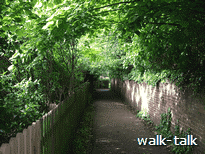 at the bottom of the garden
at the far end of the Buildings.
at the bottom of the garden
at the far end of the Buildings.
We zigzag with the path

and turn into
the railed garden on the right,

walk through it to the gate diagonally opposite site ahead and on our left.
The Council Offices are in front of us.
We skirt the offices,
 keeping them to our left
keeping them to our left
until we come to the
front entrance.

If the offices are open, we log into reception to view the St Albans Tree Book of Remembrance
which
is on the balcony above us .
.
We go up the open staircase,

and
go left to the end of the balcony

where we can
see the open

St Albans Tree Book of Remembrance.

If we
want to view pages within the book,

we need
to ask for a member of the Sustainability Team to open the case and let
us see pages other than those on display.



The original avenue of limes made the town centre truly beautiful in the summer. St Peter Street was referred to as "one of the loveliest boulevards in Europe". The first photograph shows us St Peter Street in the 1940s, the second in the 1970s. The photographs are from the slide collection in the Local History section of the Hertfordshire Library Service in St Albans.

Elsie Toms tells us in 'The Story of St Albans' (1962) that the St Peter's Street lime trees "were planted in 1881 at the expense of a private citizen, Mr H, Gotto" (Toms, 1962).
But vwoop! They were
all to be cut down and dug out.

Individuals remonstrated with the Council officials: there seemed to be no plan to replace the trees - and even if the trees were replaced, it would be ages before the saplings grew to a size where they gave again the lovely green-avenue feel to the Street.
Councillor Bill Morris was one of the people who worked tirelessly to see the trees replaced. "Trees are the 'living furniture of our streets'" is the dedication he gave to his tree in the Tree Book of Remembrance.
It was Eric Roberts, then chairman of the Civic Society, who proposed a scheme of sponsorship to overcome the Council's reluctance to commit to the huge expenditure required to replace the trees. Eric had seen such a scheme work well in Folkestone. As it has done here.
Three of the London Planes in St Peter Street were gifts of the Civic Society:
one "In
appreciation of St Albans",

one for
the 40th anniversary of the Civic Society,

and one in
memory of Derek Arnold "for his contribution to St Albans and work for
the Civic Society".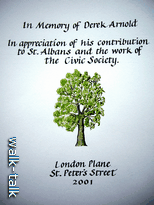
What a difference the trees
make to the street scene.
The sponsorship scheme is still in effect, now managed by the Council's Sustainability Officer, currently Trevor Brennan (St Albans Council 01727 819466). A tree can be sponsored for as little as £50, depending on the type of tree. It costs the Council a great deal more than that to acquire, plant and maintain the tree. The Council even promises to replace the tree if required. The willingness to bear the extra cost is a measure of the Council's commitment to the scheme.
The Tree Book of Remembrance
 was made by
I R Dorset of 'By George'.
was made by
I R Dorset of 'By George'.
On the opening pages
are Philip Larkin's poem
'The Trees'
and the St Albans
Coat of Arms and book title.

Each tree has a page of commemoration beautifully written and illustrated by Linda Williams.
Some trees are to commemorate a birth:

Evan James Bowers ,
Helen Catherine Davies
,
Helen Catherine Davies
or grandchildren:
Isabel and Oliver Driscoll.
Many gifts commemorate a life:
Michael Wilson "No said the bird,
for the leaves were full of
children hidden excitedly containing laughter" ,
,
a purple beech in Clarence Park;
Philip Williams, a silver
birch in Hamilton Road;
Marion
Mobey, a silver birch in Woodland Drive;
Jenny Perry for her husband Colin ,
a larch and an oak in Marquis Lane;

Lilian
Calder, a sweet gum in Hatfield Road;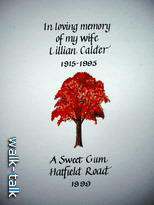
H. Irvin
King, a silver birch in Ramsey Close;

Betty Hurst and Wilf Hurst "Much loved Friends and Neighbours",
an
amelanchier lamarckii in Forefield;
Geoff Butler, a London Plane
in St Peter Street;

Cecil Pepper and Winnie (neė
Sanders) Pepper, a London Plane in St Peter Street;

Harold and Dorothy Head, a
London Plane in St Peter Street;

Ron Price "To capture the
beauty of Autumn" a beech;

Julian Graham Tilling, a
London Plane in St Peter Street;

Russell
Cannon "who lived here" a field maple outside 19 Netherway;

Margaret
Joyce Bowen, a hawthorn in Ragged Hall Lane;
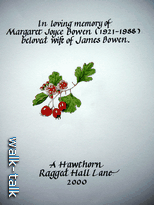
Alice Edith
Reid (Edie), a London Plane in St Peter Street.

Some of the gifts of trees were to share joys, thoughts or ideas:
"Happy years living in St Albans"
from Lynn and Mike Levy a
London Plane in St Peter Street;

"A fool sees not the same tree that a wise man sees" Wm Blake
from the Rose/Ives-Rose
family a London Plane in St Peter Street;

"In celebration of Friendship and Goodwill - deep roots and many branches"
from Kate Morris a London
Plane in St Peter Street.

All the trees were gifted to enhance St Albans, some specifically so:
"For the Pleasure of Future Generations"
from Arnold James Ltd,
Building Services Engineers a London Plane in St Peter Street;

"To maintain a green heart in
our City" from Cllr Peter and Mrs Veronica Peters a London Plane in St
Peter Street;

"For tomorrow" from Sandra
Ward and Ian Sanders, a tilda euchlora in Clarence Park.
We have mentioned the trees gifted by the Civic Society. Other organisations have given us trees:
St Albans Architectural and Archaeological Society
"A record of gratitude for our Civic Heritage"
a London
Plane in St Peter Street;

The St Albans and District Footpath Society
in memory of Professor Ian Douglas Morton
15 trees in
Rothamstead Park;
Alpin Close Residents Association
a prunus
avium plena in Alpin Close:
Soroptimist International of St Albans District
"as a living symbol of their role as a global voice for women"
a London
Plane in St Peter Street;

Rainbows, Brownies and Guides
"Future citizens of St Albans"
a London
Plane in St Peter Street;

Residents
of Meautys gave a flowering crab.
Two schools have given trees:
St Albans High School for
Girls
and St Albans School,
 each
a London Plane in St Peter Street.
each
a London Plane in St Peter Street.
Firms have given trees: we have mentioned the gift of Arnold James Ltd.
Duncan Clark plc gave a London Plane in St Peter Street
to commemorate the new
millennium;
One or two gifts are personal or family commemorations:
Peter and Pat Hurford "With gratitude for 21 years as Cathedral Organist and 40 years in St Albans"
a London Plane in St Peter
Street;

Robert Harper and family a
golden hornet in Rothamstead Park.
One gift commemorates an event:
"To recall the success of the 'Save Gombards Yew Group' and the help of Diane Fear"
a London Plane in St Peter
Street.
Mayors have gifted trees in appreciation of their term of office:
Roma Mills has given three trees specifically to commemorate her term of office
- a walnut in Verulamium Park,
a walnut in Verulamium Park,
- a
white mulberry in Clarence Park

- and a sweet gum in Rothamstead Park;
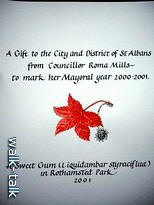
Also to celebrate Roma Mills’ term of office as mayor,
the first of the new millennium, a robinia was planted at Batchwood.
In the speech that led up to the ceremonial planting of the tree, it was made clear that the tree had been chosen to link Ms Mills with “another radical social reformer”, William Cobbett, who encouraged the planting of robinia for its structural strength.
Ms Mills was presented with a stainless steel spade to commemorate the planting.

John
Peters' commemoration is "for the privilege of being mayor

'The leaves of the tree are for the healing of the nations' Revelations 22:2. The tree is a gift from both he and his wife Veronica.
It is a London Plane in St Peter's Street.
Mayors have given trees to the District without them being part of the Scheme.
The recently outgone mayor, Cllr Alison Steer gave two trees as her parting gift to the city. They were planted very recently, one in Clarence Park and one in Rothamsted Park.
A tree was planted for Jim Greening as the last mayor of the City Council, before it was incorporated into the City and District. His tree is a tulip tree at Batchwood.
See later, for word - not much more than that - of a tree planted for Elsie Toms.
The writing that surrounds the St Albans Tree Book of Remembrance suggests that a tree could be sponsored to "add value to your property". So far, no one has written that as the reason for their gift to the District.
When we have looked our fill, we go
down the stairs, out of the Offices and turn right to St Peter's Street.

Immediately we see the effect on the Street of the
London Plane trees.
The "gift" trees were planted in a beige pebbly-looking substance called Amsterdam sand. It protects the tree and lets water through.
With new works, asphalt
 has
temporarily replaced the Amsterdam sand.
has
temporarily replaced the Amsterdam sand.
How long do you think temporary is?
The two small metal squares within in the square of Amsterdam sand are for watering the trees when there has not been enough rain.

The orange tube
coming up next to the tree
is to carry an electric cable
in case we want the trees to be lit.
We can think of the commemorations of the trees as we walk along St Peter Street: almost all the London planes were commemorative gifts, recorded in the St Albans Tree Book of Remembrance.
There is one exception that I know of:
it is the
last London plane on the opposite side of the road, the one outside Marks and
Spencer.

The Parks Department men dug a hole for it. They dug and they dug all day and then returned the next. There was solid concrete to get through and they had to smash through it. They were ragged by passers by about the length of time they were digging and the lack of visible progress but still they dug on. They dug for yet another full day and then decided that they had had enough. They put the tree in to the too-shallow hole, covered it with decent soil and left the tree to what they thought would be a steady decline. You can see that it is thriving: it was the first planted but, even allowing for that, it is easily the biggest of the planes. )
We can expect the planes to grow a great deal bigger. Planes grow to be magnificent trees. Their unusual bark peels off in large plates revealing patches of creamy white. The peeling bark stops its pores from getting blocked, making the tree particularly suited to withstand the pollution of city streets. The word 'Plane' is derived from old Greek, which refers to the broad leaf on the tree.
Three
of the tree s in St Peter Street are lime trees. They are t
s in St Peter Street are lime trees. They are t he
ones nearest to the Town Hall.
he
ones nearest to the Town Hall.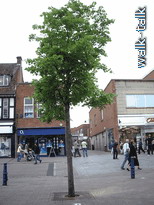 They remind us of the avenue of limes that made St Albans "the loveliest
boulevard in Europe"
They remind us of the avenue of limes that made St Albans "the loveliest
boulevard in Europe"
Tradition has it that the King of France was held where the Fleur de Lys public house now is in French Row. When it came to choosing a tree to plant close by, a tree with a French connection was chosen: a robinia, named for Jean Robin, herbalist to the King of France.
Cross St Peter's Street at the pedestrian crossing and walk left along St Peter's Street,
into Market Place

and along French Row,

at the end of which is a
lovely tall tree with un-straight branches and feathery leaves. The tree
is a ROBINIA planted, because it is at the end of French Row, for its
French connection.
It all started with the Civic Society being concerned about `the dreadful state’ of the area where the drinking fountain used to be between the Clock Tower and the High Street, outside The Great Red Lion, now Zizzi’s restaurant, at the end of French Row and next to the Fleur de Lys.
The Parks Department were, as were other Council Departments, often under fire from The Civic Society of St Albans. Mr Plant, Head of the Parks Department at the time, thought it a good strategy to suggest to the Civic Society that they design the layout and the Parks Department would put it into effect. This turned out to be a good idea because even within the Civic Society there was considerable argument and the Parks people were glad to be well out of it.
 The layout put
forward by the Civic Society included a circle of benches and small
paving stones to represent the position of the 13th Century
Eleanor
Cross, the 18th Century town pump and
Market Cross, and the 19th Century
drinking fountain.
The layout put
forward by the Civic Society included a circle of benches and small
paving stones to represent the position of the 13th Century
Eleanor
Cross, the 18th Century town pump and
Market Cross, and the 19th Century
drinking fountain.
A tree was to be positioned close to the Great Red Lion – too close for the Parks Department. By then the effects of trees on building subsidence was beginning to be understood and the Civic Society agreed to a new position a little further from the buildings.
The tree is a Robinia, chosen because it is named for the herbalist and head gardener at the French Court in the time of Henry IV and Louis XIII. His name was Jean Robin. It is in his gardens that the tree is first known in Europe and it was through his friendship and collaboration with John Tradescant the Elder that the Robinia was introduced to this country. John Tradescant was employed at nearby Hatfield House and his image is carved in the great staircase of the House.
The robinia has
lovely upward-reaching, ziggy-zaggy branches

and feathery leaves, giving a feel of weightlessness.
 The bark is deeply grooved and, with age,
becomes gnarled and interestingly weird.
The bark is deeply grooved and, with age,
becomes gnarled and interestingly weird.
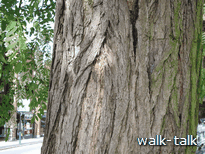
The flowers are white and
clustered.
The Latin name is Robinia Pseudoacacia and its common names are Locust Tree, Black Locust and False Acacia. It is a native of North America and first known in Europe in the gardens of Jean Robin.
Real Acacias, which grow in Australia and Africa, are Mimosa Trees. They are also, as the Robinia, of the pea family (Leguminosae).
"'Locust Tree' is
a name given to Robinia by some of the 17th century religious immigrants to
America. The Bible tells the story of how John the Baptist was kept
alive in the wilderness by eating 'locusts', which were not the insects,
but the pods of the Carob tree, which have some resemblance to the
beasties. Carob (Ceratonia siliqua) is an evergreen member of the Pea
family, which grows in hot dry areas and whose lavender-brown pods
contain 10-16 glossy seeds in a sweet pulp, which is very nutritious and
tastes rather like chocolate!
"When the Christian immigrants discovered Robinia and Gleditsia, who were
also members of the pea family and which have roughly similar pods, they
were called the "Black Locust" and the "Honey Locust" respectively.
"
(http://www.the-tree.org.uk/BritishTrees/TreeGallery/falseacaciac.htm)
And what of French Row and its French
connection? The Fleur has only just been refurbished and reopened (June
2007) and a new board in white writing on shiny black, tells us that, when he was captured after the Battle of Poitiers in
1356, King John of France was held in a building on this site.
tells us that, when he was captured after the Battle of Poitiers in
1356, King John of France was held in a building on this site.
This confirms the short statement on an older blue
board by the door.

However the illustrated board
at
the entrance to the side passage, casts doubt
on King John of France ever having been held here in French Row.

From the authority of yet another board that was outside the Fleur before it was refurbished, we can gain one clue to the reason for doubt. The board told us that King John was placed in the care of the Abbot but "at that time the house seems to have been in private hands not part of the Abbey’s possessions, a most unlikely residence for a king." 'Seems' does not add to credibility but I have been told that there is another reason for doubt: Thomas de la Mare was abbot at the time and a contemporary account of his abbacy was written by Thomas Walsingham. In that account there is no mention of King John of France being in St Albans. It is considered inconceivable that this would be the case if King John had been in St Albans even if not in the custody - sorry, 'under the protection' - of the Abbot.
However, it is certainly the tradition that the French King was kept here - the name of the passage commemorates it - and it is right that the tree should do the same.
It was the selection of this tree that gave Paul Arnold the idea of planting trees with an historical connection. The visitors and residents of St Albans can be glad, and enjoy the trees and the knowledge of their historical connections for many years to come.
Only one tree survived the First World War Battle of Verdun. It was a horse chestnut. One of its conkers was brought to England, nurtured into a sapling and, to commemorate the Battle, planted in the open area between Waxhouse Gate and the Vintry Gardens.
From the
Clock Tower, look across the High Street and see an archway.
This is the entrance to Wax House Gate, so called because there were candle makers to
the right of
the entrance.
to Wax House Gate, so called because there were candle makers to
the right of
the entrance.
Cross the High Street and enter Wax House Gate.

Go
down the hill
 until a green opens up on the left.
until a green opens up on the left.
The first
large tree,
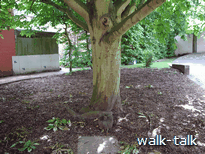 close to the path, is the HORSE CHESTNUT planted to
commemorate the Battle of Verdun.
close to the path, is the HORSE CHESTNUT planted to
commemorate the Battle of Verdun.
The City Parks
Department started to purchase trees in containers and their
supplier was a nursery in Surrey. The nurseryman had been over
to France to the battlefield at Verdun and it was he who brought
back some conkers from the only tree left standing after the
battle. He had a habit of
planting seeds in obsolete metal milk crates and that is
probably where our conker started its new life.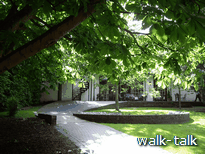
When Paul Arnold of the St Albans City Parks Department heard the story he asked for one of the saplings and contacted the British Legion in St Albans. There was one surviving “Old Contemptible” among their membership and it was he who planted the tree on the anniversary of Verdun to commemorate the Battle and in memory of the men who lost their lives.
The Battle of Verdun was especially tragic in a war of tragic battles. Verdun was seen as the gateway to Paris and Kaiser Wilhelm knew that for the French it would be Ils ne passent pas and that the French would throw men in to defend it. The Battle was interminable and tragic for both sides.
The tree is tall and beautiful. There is a short wooden post on which I suspect there used to be a commemorative plaque, but the plaque itself has gone.
There are tearooms at the end of Village Arcade off the High Street. As you sit on the veranda having refreshments there, you will see the tree below you and to your right.
A vine was planted to commemorate the links between St Albans and her twin town in Germany.
 From the Verdun horse
chestnut, we continue down Wax House Gate and enter the
brick walled Vintry Gardens ahead
From the Verdun horse
chestnut, we continue down Wax House Gate and enter the
brick walled Vintry Gardens ahead
Framed by the arch into the Gardens is a young oak
straight ahead of us.
 That is the oak planted for the
youngsters who were injured or lost their lives in a coach accident. We shall
come to that.
That is the oak planted for the
youngsters who were injured or lost their lives in a coach accident. We shall
come to that.
Now, we
turn left along the path
 with the wall on our left. and
see a vine growing along the wall.
with the wall on our left. and
see a vine growing along the wall.
The
plaque on the wall
 by the vine tells us that the vine
was planted to commemorate the
50th CIVIC EXCHANGE between Worms
am Rhein
and St
Albans in 2007.
by the vine tells us that the vine
was planted to commemorate the
50th CIVIC EXCHANGE between Worms
am Rhein
and St
Albans in 2007.
Also to celebrated 50 years of postwar friendship between St Albans and Worms am Rhein, a Kaiser Linden tree was planted in April 2007 in Clarence Park.
An ash tree to stand for justice was planted in the Vintry Gardens to mark the ‘Year of the Prisoner of Conscience’
At the end of the path, is a graceful golden ASH tree, planted as a symbol of JUSTICE.
 It was
Penny Jones who suggested planting, on behalf of Amnesty
International St Albans group, a tree to commemorate
`The Year of the Prisoner of Conscience’ in 1976.
It was
Penny Jones who suggested planting, on behalf of Amnesty
International St Albans group, a tree to commemorate
`The Year of the Prisoner of Conscience’ in 1976.
Paul Arnold of the Parks Department was asked to advise on a suitable tree and a Golden Ash tree was chosen for the Saxon tradition that justice should be dispensed under an ash tree. Certainly here in St Albans in the 12th Century, pleas were heard under "the great ash tree in the courtyard of the Abbey," and in Sussex and Hampshire, courts are recorded as being held under an ash tree.
Ayletts Nursery supplied the tree and Paul went with Penny to make sure that the tree was a good one. The Parks Department dug the hole for the tree and supervised its planting.
Amnesty International head office supported the scheme and suggested that Mukhtar Rana who had been a prisoner of conscience in Pakistan, should be involved in planting the tree and in speaking on behalf of prisoners of conscience and the way in which Amnesty International had helped in keeping his plight from being forgotten. Mukhtar Rana is an excellent orator and did justice to the occasion.
An adventure holiday for pupils of Verulam and Beaumont Schools ended tragically in a coach crash. An oak tree was planted in Vintry Gardens in memory of the scholars who lost their lives or were injured.
We saw the lovely oak tree framed by the archway entrance to the Vintry Gardens as we came in. From the corner of Gardens with the golden ash, we turn right and walk down the path and then turn right again to the OAK tree planted to commemorate adventuring school children.
The youngsters had been wind surfing on the Mediterranean and were on their way to the Ardeche to do rock climbing and canoeing when their coach driver had a brain haemorrhage and died at the wheel. Some pupils survived without injury, some were injured, many died. It was heartbreaking.
As one of the memorials to the youngsters, parents chose to plant an oak in the quiet of the walled Vintry Gardens in the lea of the great Abbey church. The oak is in the centre of the Gardens.

At its foot
is a renewed plaque telling the story and each year,
at about the time of year of the accident, flowers
are placed by the tree.
The crash was at Ledignan in France on 29 May 1985. The tree was planted on 16 November of the same year.
There are two other interesting trees in the Vintry Gardens. They have no historical connection that I know of, but they add to our rich St Albans' heritage. They are a mulberry tree and a ginkgo biloba tree
The Dowager Countess Spencer planted a cedar on the south side of St Albans Abbey and Princess Diana planted another on the other side of the Abbey to make a pair with the one her ancestor had planted two centuries before.
We make our way down by the herb-lined path to the
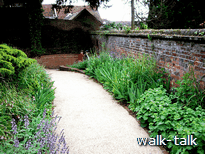
gate out of Vintry Gardens
 and turn right towards
the Abbey.
and turn right towards
the Abbey.
Ahead, to the left of the Abbey, we see a venerable
CEDAR.
Some refer to the tree as The Trafalgar Tree and
believe it to have been planted in 1805, te year of
the Battle. However,
Elsie Toms quotes one
Mr Stanley
Kent to the effect that it was planted on 25
March 1803 by
the
Dowager
Countess Spencer
- of whom see more below.
We are also told that the distinctive umbrella
shape is due to the top being broken off by boys
when the tree was young.

We turn our backs on the venerable cedar and make our way right,
round the east end of the Abbey
and
into the churchyard.
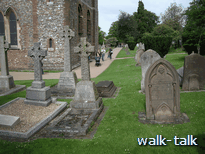
There we see a young CEDAR
 that
was planted by a descendant of the Countess,
Princess Diana,
when she came to the dedication of the rose window
in the north transept of the Abbey.
that
was planted by a descendant of the Countess,
Princess Diana,
when she came to the dedication of the rose window
in the north transept of the Abbey.
We can look up and see the window
 and,
and,
if we want to see it from inside the Abbey,
go
in through the door beneath it, entering quietly in
case there is a service.

Princess Diana's rose window is behind us and above.
If we do go into the Abbey, we can either walk to the right and through the Abbey, out through the West door, and turn left in front of the West face.
or come
back out through the same door and turn left, walk
to the end of Abbey
walk
to the end of Abbey
and turn left across the
West front.
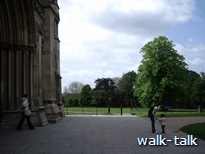
There was a surge of support for the ecumenical movement in the 1970s. A Holm oak, a tree with Roman Catholic associations, was chosen to be planted in the grounds of the protestant Abbey.
We walk across the front of the West face of the Abbey,
out through the railings into the Abbey
Orchard and continue on the path ahead.
Soon after a four-way path crossing, we see the HOLM
OAK planted for ecumenism ahead and a bit to the right.
and continue on the path ahead.
Soon after a four-way path crossing, we see the HOLM
OAK planted for ecumenism ahead and a bit to the right.

The Holm oak, Quercus Ilex, is also known as the holly oak or the evergreen oak: holm is thought to be the Saxon word for holly.
Paul Arnold chose the holm oak because of its associations with the Roman Catholic church which, as J H Wilks tells us, caused the poor victimised tree to be persecuted along with human believers:
"[The holm oak] was to be found growing on many monastic sites when Henry VIII’s henchman, Thomas Cromwell, was dismantling the Roman Church in Britain and destroying its establishments. With its Mediterranean origins the ilex or holm oak symbolised the Papacy to the reformers and so gained ill repute."
The authorities at the Abbey accepted the ecumenical project proposed by the Parks Department and the local Roman Catholic community was keen and sent word to Rome. The pope was pleased to send a nuncio to officially plant the tree. The tree was to be planted in the Abbey orchard.
The holm oak destined for the Abbey orchard was in the Council nurseries in New Greens. It was a big tree and hard work to move. The team dug trenches on four sides of the tree and lowered a steel hawser into the trenches. They dug a trench from the trenches to a nearby telegraph pole and anchored the hawser to it. They then tightened the hawser until it sliced like cheese wire through the huge root ball of the tree. They encased the tree and its roots and surrounding earth in sacking, “like a pudding cloth”, and used a skip lorry to transport it.
A hole of appropriate enormous size had been prepared, not without difficulty. As they dug, the men came upon the top of a brick arch. A member of the Museum staff had to be consulted and he suggested it was the top of a tunnel from the Abbey to the Sopwell nunnery. I have no idea whether he was joking. I do know that it has been suggested that the earlier Saxon Abbey church was further down the Abbey orchard below the present one masterminded by Paul of Caen. There must have been a time when there was a need for passages between the old church and the new. To preserve the arch for future generations to ponder over, the hole was re-dug a bit further away.
The Parks people lowered the tree into the hole and packed a good bit of soil round it but left a bit of space round the tree and more of the compost made from autumn leaf sweepings to finish the job. They also left a small heap of carefully sifted compost for the official “planting”. When it is a lady mayor doing the job it is the equivalent of putting a spoonful of soil on a trowel and ceremonially tipping it round the base of the tree while photographs are taken. However, the Nuncio was no lady mayor but of the more robust Christian kind and knew how to shovel soil and plant a tree properly. He polished off the sifted compost in one sweep and dug his next shovel into the unsifted compost.
“We are going to get the last laugh,” said one of the Parks men. They had not been included in the introductions to the Nuncio: the Abbey officers at the time had presented each councillor, the Lord High Sheriff of Hertfordshire and the church people for the Nuncio to shake hands, but not the Parks men. Apart from the personal snub, the Parks People regarded the project as their own, and they were miffed.
The laugh was that the composted leaves collected from pavements and park corners held all sorts of unexpected debris including condoms. It all floated into the air as the Nuncio shovelled the compost round the tree base.
Paul Arnold has two other Holm oak associations to share with us:.
The first is a legend that there is a holm oak in Rome that pre-dates the founding of the City.
The second is that Holm oaks appear
on the top of a tower on labels of olive
oil from Lucca. The tower is the Guinigi Tower,
one of a
group of mansions occupied in mediaeval
times by the Guinigi family in Lucca.
The Tower was
started in 1384 and it is made of sandstone
and brick. From the top of the tower seven
Holm oaks grow. Were they planted for the
shade they would afford as people enjoyed
the wonderful view from of the
town and surrounding countryside from the
top of the tower? Or were
they planted for their holy symbolism?
It seems extraordinary that such substantial
trees should be growing on top of a
building, a mediaeval tower at that.
The Holm oak has dark green shiny waxy leaves in the nature of holly leaves, but the shape of the leaf is like neither an oak nor a holly. It is about two inches long, narrow and pointed.
Fruits are small, hairy and acorn-like.
STAND, the anti-nuclear group, planted a Pagoda Tree to mark Hiroshima Day.
A pagoda tree was planted half way down and offset by a few metres from the path that runs to the right of the holm oak, down through the Abbey Orchard to the Fighting Cocks. The tree has not survived and Penny Jones, who was there, says she has never seen a tree so unceremoniously shoved into position.
The tree was planted to mark the first Hiroshima Day in 1985, 40 years from the dropping of the nuclear bomb on the city of Hiroshima in Japan. Also to mark the Day, people have told me that they remember candles being floated across Verulamium lake. If you have memories/knowledge of that ceremony, do share them with us.
The Latin name for the Pagoda tree is Sophora japonica. The tree is also known as the Chinese scholar tree, and “soph” is the route of the Greek word for wisdom or knowledge (as in philosophy being the love of wisdom). To me, it is appropriate to have chosen a tree with connotations of wisdom: one hopes we might gain the wisdom to work out how to refrain from war.
However, Francis George Heath in 'Our British Trees and How to Know Them', tells us that "Sophora is from the Arabic sophero meaning papilionaceous ( butterfly-shaped) flowering". There is a pretty thought. Heath also tells us that "the flowers and fruit yield a fine yellow dye" (Heath, Francis George, 'Our British Trees and How to Know Them' 4th Ed (revised), Hutchinson & Co.)
Although the japonica part of its Latin name implies that the Pagoda tree is a Japanese plant, and is the reason for its choice to commemorate Hiroshima Day, it is in fact native to China. It was introduced to Britain in 1753 by the famous nurseryman James Gordon.
The tree’s common name Pagoda tree probably arose because it was often planted in the grounds of Buddhist temples in Japan. It is still popular as an ornamental tree due to its hanging inflorescences (flowering spikes) of creamy white flowers. In Japan, its durable wood was used for pillars and door frames, (http://www.rbgkew.org.uk/plants/trees/sophora_japonica.html).
A huge specimen of a Pagoda
tree can be seen behind a large white house,
 Abbey
Gate Office, in Abbey Mill Lane that runs alongside
the Abbey Orchard. If we walk across the grass to
the right, we can see the pagoda tree behind and to
the left of the house.
Abbey
Gate Office, in Abbey Mill Lane that runs alongside
the Abbey Orchard. If we walk across the grass to
the right, we can see the pagoda tree behind and to
the left of the house.
 The variety
selected to commemorate Hiroshima Day is not
necessarily the same variety but we can see the
great height and spread of the tree that makes it
appropriate to remind us of so momentous an event.
The variety
selected to commemorate Hiroshima Day is not
necessarily the same variety but we can see the
great height and spread of the tree that makes it
appropriate to remind us of so momentous an event.
The tree is similar in leaf to the Robinia pseudoacacia (see The French Connection above, but is even more craggy and gnarled with twisted branches and pendulous shoots. Both trees are members of the pea family.
Note that there is a plaque for Peace at the entrance into Sumter Yard from Holywell Hill .
Also in Abbey Orchard, was planted a tree for Elsie Toms.
A mayor of St Albans and local chronicler, Elsie Toms, is thought to have been commemorated by the planting of a tree 'half way down Abbey Orchard'. Elsie Toms wrote ‘The Story of St Albans’ published in 1962.
Please share any memory/knowledge you have of the tree.
An avenue of limes and horse chestnuts is known as Lady Spencer's Grove.
Looking down hill, we walk to the far left
 hand bottom corner of Abbey Orchard
hand bottom corner of Abbey Orchard
and turn left
along a pathway.  This is Lady Spencer's
Grove,
an avenue of LIMES and HORSE CHESTNUTS
This is Lady Spencer's
Grove,
an avenue of LIMES and HORSE CHESTNUTS
The St Albans home of the 1st Duke and Duchess of Marlborough and their descendants the Earls Spencer was Holywell House in Holywell Hill.
It is said that the Dowager Countess Spencer's favourite walk to Verulamium was along this path. Soaring horse chestnuts and limes form an avenue with the feel of a fan-vaulted cathedral.
We walk along the path with the Abbey Primary School on the left
and out in to
Grove Road.
We turn right and curve left with the road into Holywell Hill
at The Duke of Marlborough
pub, the name of which commemorates the Marlborough
connection.
If we look left up Holywell Hill, we see a blue circular plaque on a wall on the other side of the road. The plaque commemorates the position of the Holywell House, the home of the 1st Duke and Duchess of Marlborough and their descendants the Earls Spencer. Holywell Hill had to curve right out and round the Holywell House and its drive and outbuildings. In 1837 all were demolished in order to straighten Holywell Hill. (Elsie Toms 1962 The Story of St Albans, Revised Edition 1975 p146)

HOLYWELL HOUSE
(Residence of the Dowager Countess Spencer)
Hertfordshire
London: Published by Vernor, Hood & Sharpe,
Poultry, Sepr 1, 1806
Engraved by J. Storer from a Drawing by G,
Shepherd
From the
Beauties of England & Wales
Holywell House was part of Sarah Jenyn's dower when she married John Churchill who was later made Duke of Marlborough. Sarah came from a local family (she was christened in the Abbey) and she and her husband lived frequently in the house and loved it, despite having Blenheim as their main seat.
Through a a lack of male heirs and via a complicated route involving a special dispensation, Charles, the second son of Sarah's daughter Anne became the 3rd Duke of Marlborough, vacated Althorp, the Spencer family seat, and moved to Blenheim Palace. His younger brother John inherited Althorp, 200 years later to be the home of the young Lady Diana Spencer who became Princess Diana.
That same John Spencer who inherited Althorp, was the favourite grandson of our Sarah Duchess of Marlborough, and she left him her personal property including Holywell House.
John Spencer's son, also John Spencer, married Margaret Georgiana, daughter of 2nd Earl Granville, and became 1st Earl Spencer in 1765. John died in 1785 and his widow, Margaret Georgiana, our Dowager Countess Spencer who planted the great Abbey cedar and gave her name to Lady Spencer’s Grove, left her son George and his wife Lavinia to live at Althorp and moved herself in to Holywell House, St Albans.
The Dowager Countess Spencer lived for thirty more years after her husband died and was a local benefactor, founding a school for girls. It was "in the north west angle of a field now covered by Thorpe Road at the end of Belmont Hill", across and up Holywell Hill from where we are standing. "The girls wore a uniform and and it was known as the Greencoat School. It remained until [the Dowager Countess'] death in 1814 [at the age of 77]. (Elsie Toms 1962 The Story of St Albans, Revised Edition 1975 p128).
The Spencer family still own property in St Albans.
There are two more sets of trees in the walk: a circle of American trees planted for the 75th anniversary of Rotary International in Chicago and a grove of pine-nut trees for the Roman triangular temple. They are not as close as have been the other trees in the walk. They are in the far corner of Westminster Lodge open space and the near side of Verulamium Park, respectively. To view them and walk back up to the town is about half a mile of the walk, but you may prefer to walk straight up Holywell Hill which becomes Chequer Street and then St Peter's Street.
A ring of American trees was planted in Westminster Lodge park to commemorate 75 years since the founding of Rotary International in Chicago on 23 February 1905.
From the Duke of Marlborough pub, we go left a few paces down Holywell Hill and then right,
over the hump-backed
bridge across the Ver

into
Westminster Lodge water meadows.

We are
making for the far diagonal corner across
the open space.

Instead of walking diagonally across the grass, we can at any time make our way left on to the road that becomes a track that becomes a path.
On the
far side of the road is the swimming pool
with its distinctive green slide tubes (no
longer in use), then a car park, then
another car park for the Abbey View Golf
Course and then, beyond what is now a path,
the running track with its long low brick
changing rooms.

We aim for
the far end of the hedge round the running
track.

When we get there, we turn left,
 leaving the hedge on the left and walk up
hill.
leaving the hedge on the left and walk up
hill.
The cluster of trees ahead,
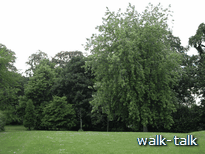 surrounding a tree stump,
surrounding a tree stump,
is the circle of American trees.
Paul Arnold told me of the planting - it was he who advised on the species – but it is to Vic Coombs’ book ‘Seek a Tree in Verulamium Park’ to which we are indebted for its exact location and the identification of the trees planted. You can buy his book in The Inn on the Park.
Going by Vic Coombs' identification, and taking the tree stump as the clock centre and 12 o'clock at the top of the hill, the trees are as follows:
Closest to us, at 6
o'clock, is a SILVER MAPLE,
 the large tree with
upright arched branches that we first see as
we approach the circle. It has an obviously
maple leaf, although particularly deeply
incised and fluttering to show the paler
underside from w
the large tree with
upright arched branches that we first see as
we approach the circle. It has an obviously
maple leaf, although particularly deeply
incised and fluttering to show the paler
underside from w hich it gets is common name
Silver Maple.
hich it gets is common name
Silver Maple.
The greenish-yellow flowers cover the tree before the leaves unfold, first reddish-orange then pale green and finally yellow and brown, and a few of them scarlet. (Michell and Coombes 1998 "The Garden Tree" Orion Publishing Group)
The Silver Maple is a native of Eastern North America. Its Latin name is Acer saccharium, not to be confused with Acer saccharum, the Sugar Maple. We always wanted to know that.
Closer into the circle and between 5 and 6
o'clock is a ROWAN of which
 Francis
George Heath, in 'Our British Trees'
Hutchinson & Co, has a delightful suggestion
to share with us:
Francis
George Heath, in 'Our British Trees'
Hutchinson & Co, has a delightful suggestion
to share with us:
"Their spells were vain: the hags returned
"To the Queen in sorrowful mood,
"Crying that witches have no power
"Where is a Ro'an-tree wood."
Heath then wonders whether McBeth's "Aroint thee, witch" could be a printer's error and should read "A Rowan tree, witch," much as one might cry "Garlic, vampire" in the hopes of seeing off a blood-sucking bat in human form. Heath claims that Shakespeare is the sole authority for 'aroint' and certainly it is not a word I commonly use, and nor does MS Word spell-check know it. But then neither of us knew papilionaceous (see the Pagoda Tree, above) nor glabrous (see the Cockspur Thorn Tree below).
The Rowan is of the genus Sorbus, and we know it best as the Mountain Ash. It has pinnate leaves, smaller than those of the ash. It is difficult to know why a Rowan was chosen for our American circle. Although the genus Sorbus is "diverse and widely distributed there are no varieties native to The Americas" (Mitchell, Alan and Coombes, Allen 1998 'The Garden Tree', Orion). Perhaps it was planted to keep British witches at bay.
On the outer ring
at 5 o'clock is a LIME, which Vic Coombs has marked
as Common Lime but the leaves
seemed exceptionally large to me and I
wondered when a large-leafed lime becomes a
Broad-Leafed Lime.
which Vic Coombs has marked
as Common Lime but the leaves
seemed exceptionally large to me and I
wondered when a large-leafed lime becomes a
Broad-Leafed Lime.

My photograph shows my
hand alongside a leaf.
 My hand is 7½ inches
(19cm) long and 3½ inches (9cm) wide across
the four fingers: a large hand and the leaf
is bigger. However, Mitchell and Coombes (1998) tell us
that the leaves of the Broad-Leafed Lime
"are no larger than in the Common Lime". On
the other hand, the leaves of the American
Lime "are moderately or very big, shiny and
marked by pale parallel straight veins.
Unlike other limes, the leaves are the same
rich colour beneath" (Ibid.) If you go,
look underneath the leaves and see what you
think. The leaves are certainly shiny. The
American Lime would be the more appropriate tree
to plant: the common lime is native only to
Europe, the American lime to Eastern North
America.
My hand is 7½ inches
(19cm) long and 3½ inches (9cm) wide across
the four fingers: a large hand and the leaf
is bigger. However, Mitchell and Coombes (1998) tell us
that the leaves of the Broad-Leafed Lime
"are no larger than in the Common Lime". On
the other hand, the leaves of the American
Lime "are moderately or very big, shiny and
marked by pale parallel straight veins.
Unlike other limes, the leaves are the same
rich colour beneath" (Ibid.) If you go,
look underneath the leaves and see what you
think. The leaves are certainly shiny. The
American Lime would be the more appropriate tree
to plant: the common lime is native only to
Europe, the American lime to Eastern North
America.
At 4 o'clock is a VINELEAF MAPLE, which has a most un-maple-like leaf:
the leaves have three
leaflets,
 each
soft and floppy (Mitchell and Coombes, 1998).
each
soft and floppy (Mitchell and Coombes, 1998).
 The
vineleaf maple was introduced to the west
from Japan some time before 1870. Not North
American, then.
The
vineleaf maple was introduced to the west
from Japan some time before 1870. Not North
American, then.
Mitchell and Coombes promise us that "the pairs of arched catkins with their tiny winged fruit dominate the foliage until autumn when the leaves turn pale yellow then brown". I noticed no such catkins or fruit in late May. Perhaps we were in between catkins and fruit.
At 3 o'clock a
COCKSPUR THORN, which
is native to Eastern North America and
is of the hawthorn (Craetegus) family. The
leaves look nothing like the leaves of our
ubiquitous Common Hawthorn, neither in shape nor
texture.
which
is native to Eastern North America and
is of the hawthorn (Craetegus) family. The
leaves look nothing like the leaves of our
ubiquitous Common Hawthorn, neither in shape nor
texture.
 In Mitchell and Coombes we read
that "The feature that separates the
Cockspur thorn from any of its hybrids is
its glabrous flower and fruit stalks." I am
grateful to Mitchell and Coombes for the
word 'glabrous'. I did not know the word -
and nor does MS Windows so we need not beat
ourselves up about it. All sorts of possible
meanings came to mind, much more interesting
than reality: the Oxford dictionary
baldly gives us "bald". It is good to
have another useful adjective with which to
extend our vocabulary: first papilionaceous,
then a reminder of aroint which I am
determined to use more,
and now glabrous.
In Mitchell and Coombes we read
that "The feature that separates the
Cockspur thorn from any of its hybrids is
its glabrous flower and fruit stalks." I am
grateful to Mitchell and Coombes for the
word 'glabrous'. I did not know the word -
and nor does MS Windows so we need not beat
ourselves up about it. All sorts of possible
meanings came to mind, much more interesting
than reality: the Oxford dictionary
baldly gives us "bald". It is good to
have another useful adjective with which to
extend our vocabulary: first papilionaceous,
then a reminder of aroint which I am
determined to use more,
and now glabrous.
We can look forward to the leaves turning orange and red in the autumn and to the small red fruits that will persist on the shoots through winter (Mitchell and Coombes 1998).
At 2 o'clock is a
variegated NORWAY MAPLE, which is a native of Norway but perhaps it was chosen for its
"spectacular" flowering.
which is a native of Norway but perhaps it was chosen for its
"spectacular" flowering.
 Mitchell and Coombes (1998) tell us that
"it approaches the spectacular when it is thickly covered in bunches of
bright acid-yellow-green flowers towards the end of March, when few
other trees are flowering and before the leaves emerge". We need to put
a date in our diaries to remind us to come back at the end of March
Mitchell and Coombes (1998) tell us that
"it approaches the spectacular when it is thickly covered in bunches of
bright acid-yellow-green flowers towards the end of March, when few
other trees are flowering and before the leaves emerge". We need to put
a date in our diaries to remind us to come back at the end of March
- and for October when "a few trees turn bright orange while the majority are reliably butter yellow all over during most of October". Which would you have chosen?
At 12 o'clock is another
LIME. Are these leaves less shiny, do you think?
Are these leaves less shiny, do you think?
Vic Coombs makes no distinction between the two limes in the circle.
Very much on the outer ring at 11 o'clock is another COCKSPUR THORN.
Closer into the circle at 10 o'clock is another LIME.
At 9 o'clock is a
KENTUCKY COFFEE TREE, which
I thought at first was another Rowan: it,
too has pinate leaves.  "The leaves are hugely and doubly compound, about
the biggest of any hardy tree," Mitchell and Coombes (ibid) tell us.
This is confusing because what we might call a leaf is long for its
width but small on the Kentucky Coffee Tree.
"The leaves are hugely and doubly compound, about
the biggest of any hardy tree," Mitchell and Coombes (ibid) tell us.
This is confusing because what we might call a leaf is long for its
width but small on the Kentucky Coffee Tree.
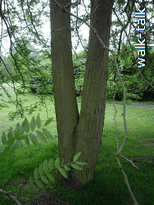 The small jobs, however, are,
strictly, a 'leaflet'. The groups of leaflets are the leaves or,
in the case of the 'double compound' leaves of the KCT, a 'group of
groups of leaflets' is technically a 'leaf'. This, M&C (ibid) tells us,
makes each leaf nearly a metre long: "they branch and branch again". And
"rather oddly, when all the leaflets and minor leaf stems are shed in
autumn," the great leaflet drop? " the central leaf stems remain radiating
from the branch ends." See you in autumn.
The small jobs, however, are,
strictly, a 'leaflet'. The groups of leaflets are the leaves or,
in the case of the 'double compound' leaves of the KCT, a 'group of
groups of leaflets' is technically a 'leaf'. This, M&C (ibid) tells us,
makes each leaf nearly a metre long: "they branch and branch again". And
"rather oddly, when all the leaflets and minor leaf stems are shed in
autumn," the great leaflet drop? " the central leaf stems remain radiating
from the branch ends." See you in autumn.
Male and female flowers are on separate trees and "are pretty but not spectacular. They are rarely produced except in areas with very hot summers" (ibid). In my photograph, there are what appear to be flowers or embryo fruits. I can find no photographs or descriptions of male or female flowers. It would be good to hear from you if you have information to share.
Vic Coombs (in 'Seek a Tree in Verulamium Park") tells us that the fruits are "contained in a large leathery red brown hanging pod about 10 inches (25 cm) long and persisting for some time. Seeds are said to be roasted to make a coffee-like beverage." Mitchell and Coombes are silent on the subject.
The Latin name for the the KCT is Gymnocladus dioica and it is a native of the Eastern United States.
At 8 o'clock is an
INCENSE CEDAR
 which
is a cyprus and not a cedar at all and does
not seem to have any connection with incense. Thank you. Its
Latin name is Calocedrus (which you might think was a cedar) decurrens.
which
is a cyprus and not a cedar at all and does
not seem to have any connection with incense. Thank you. Its
Latin name is Calocedrus (which you might think was a cedar) decurrens.
It is a native of West North America. Vic Coombes describes the wood as '"aromatic". Mitchell and Coombes (1968) tell us that the "foliage emits a strong scent of shoe-polish on the lightest handling".
On Pick of the Week on BBC Radio 4 on Sunday 24 June 2007, an item was chosen from the Book of the Week 'Wildwood: A Journey through Trees' by Roger Deakin. The piece chosen told us that the incense cedar grows to 140 feet high in Oregon and that it yields ideal wood for making pencils. We were given the number of thousand pencils yielded from a single tree and told that the smell of such pencils is "nutty".
Aromatic or nutty wood, and leaves smelling of shoe polish but still no word of providing the incense we associate with religious ceremonies.
Closer in to the circle at 7 o'clock is another COCKSPUR THORN.
And, finally, we have
the OAK
 in
the centre of the circle.
Vic Coombs ('Seek a Tree in Verulamium Park') labels the oak as an
English oak, Quercus robur.
in
the centre of the circle.
Vic Coombs ('Seek a Tree in Verulamium Park') labels the oak as an
English oak, Quercus robur.
I wonder however whether it might not be an American oak, Quercus rubra, which is a native of North America and is said by Mitchell and Coombes to have a leaf of 8 inches (20cm) rather than the English oak's 3-5 inch (8-12 cm) leaf (Eric A Bourdo 'The Illustrated Book of Trees', Salamander Books Ltd, 1999). Again, we can see from the photograph that
my nearly 8-inch hand
 is
pretty much the same size as the leaves.
is
pretty much the same size as the leaves.
Although Paul Arnold suggested appropriate varieties of tree, it was the Rotary Club that took responsibility for selecting and planting them.
The trees in the Circle are not all natives of America. This could either be because the aim was not to select natives of America but to have international representation and show the spread of the Rotary movement. Or it might be because the trees are not correctly identified.
Vic Coombs
quotes the "plaque
 on
a tree stump referring to a group of trees of
American Origin surrounding the English Oak" ('Seek a Tree in Verulamium
Park'). 'Origin', of course, could mean that the saplings came from
seeds gathered in America - as was the Verdun conker (see the Battle of Verdun
horse chestnut, above).
on
a tree stump referring to a group of trees of
American Origin surrounding the English Oak" ('Seek a Tree in Verulamium
Park'). 'Origin', of course, could mean that the saplings came from
seeds gathered in America - as was the Verdun conker (see the Battle of Verdun
horse chestnut, above).
The plaque is now gone from the tree stump but the current deputy mayor, Cllr Geof Harrison, is on a mission to get Rotary to replace it.
A grove of stone pines, also known as Italian pines, was planted as close as was allowed to the Triangular Temple in the Roman city of Verulamium.
If we go up hill through the American Circle of trees and pass to the right of
a tall spreading sycamore tree,

we see
a path going through to the right.

We take that path

and come out at the
foundations of the Londinium Gate
 that
stood in the wall around the Roman city of
Verulamium.
that
stood in the wall around the Roman city of
Verulamium.
We can see from the illustration on the board
 how
many tiers of flint between layers of red tiles went into the towers of
the Gate. From looking at the remains of the wall to our left, we can
see the height of each tier and realise how very imposing the towers
must have been.
how
many tiers of flint between layers of red tiles went into the towers of
the Gate. From looking at the remains of the wall to our left, we can
see the height of each tier and realise how very imposing the towers
must have been.
From the lines of the foundations, we can see the pedestrian and cart ways in, and the cart and pedestrian ways out, and imagine coming through the gate and into the Roman town where we would see ahead a triumphal arch and beyond that the Triangular Temple, about 200 yards from where we are standing. (See a Plan of Verulamium drawn by David Williams, Niblett, Rosalind, 2001, "Verulamium" Tempus, p90)
In Verulamium Museum there was on display a votive bowl filled with pine nuts because pine nuts, seeds of the stone pine, pinus pinea, were found in excavations of that Triangular Temple (Reports of the Society of Antiqueries, p120). When Paul Arnold of the City Parks Department saw the little bowl of nuts, he thought, "That’s our next historical tree planting."
A grove of pinus pinea was planted as close to the Triangular Temple in Verulamium Park as the archaeological authorities would allow. If we look ahead and to the left,
we see a line
of trees
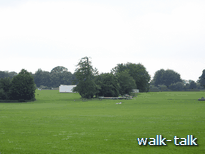 going away from us, the white hypocaust building just visible
beyond and to the left of it.
going away from us, the white hypocaust building just visible
beyond and to the left of it.
It is at this end of that line of trees that the grove was planted. Not all of the trees have survived and when Paul Arnold saw that a replacement was not a pinus pinea, he realised that the current Parks team did not know of the historical connection. That the story of the trees might not be quite lost, is one of the reasons for this write up.
Paul Arnold knew that the "tree [pinus pinea] has always been valued in Italy for its edible seeds and, as their husks have been found in the refuse heaps of Roman encampments in Britain, they appear to have been sent over for the use of the army in occupation" (Bean, W.J., “Trees and Shrubs Hardy in the British Isles”, Vol 3., 8th Ed., 1970 2nd Imp. 1980).
On hearing of this, I inferred, with my 21st century layman’s understanding of offerings that, if presented in the right spirit, even a staple food such as was issued to soldiers, would be an appropriate offering to a god or goddess. However, Rosalind Niblett, then archaeologist at Verulamium Museum, in 'Verulamium: the Roman City of St Albans' (Tempus Publishing Ltd., 2001) sheds a very different light on the pinus pinea seeds:
"The suggestion that the temple was dedicated to Cybele is based on the discovery in what must have been votive pits in the temple court, of burnt seeds and scales from pine cones of the Italian pine (pinus pinea). The pine figured in the rituals associated with the worship of Cybele and her consort Attis but the Italian pine is not a species that grows naturally in Britain, either the cones or a tree itself must have been imported."
Cybele was a goddess of earth, mountains and caverns and was worshipped as a protector of fortified places and cities in general. As great protectress of cities, it is appropriate that her temple is close to the main entrance to Verulamium. The cult of Cybele increased in popularity in Britain through to the 4th Century. For more about the bizarre rituals associated with Cybele and her priests, not recommended to be read too soon after breakfast, see http://news.bbc.co.uk/1/hi/england/1999734.stm or, if that fails, Catterick Burial. It is to be noted that "An inscription on a pot found in a grave at Dunstable, 10 miles along Watling Street, tells us that the jar was dedicated to the dead person by a man called Regillinus, on behalf of fellow worshippers of Cybele." (Rosalind Niblett 'Roman Hertfordshire', Tempus Publishing Ltd.)
Incidently, not only were the pine seeds valued for their nutritional value but were thought to be an aphrodisiac. ‘The Greek physician Galenos, of the 2nd century AD, suggests that a mixture of pine seeds, honey and almonds taken before bedtime for three consecutive evenings can increase sexual potency.'
We walk down hill to the right and skirt the railings round the Gate and head for where the grove of pinus pinea was planted, at the near end of the line of trees gong away from us with the white hypocaust building visible beyond it to its left.
We shall be walking over the Temple when we are 200 metres from the Gate and 50 metres from the concrete path along the hedge line on our right. A football pitch is about 90 metres long and there are usually a couple of pitches marked out and their goal posts clearly visible between the grove and Londinium Gate so that we can think "two football pitches from the Gate and half a football pitch from the hedge".
The Temple had an external altar at its blunt point facing Londinium Gate with a backdrop of the plastered walls of the temple, probably embellished with Purbeck marble, fragments of which were found in the 1930s excavation (Niblett 2001).
"The pine nut, Pinus pinea, is often called the 'Stone Pine' and sometimes the 'Umbrella Nut'. These names apparently come from the idea that this tree grows well in stony ground and also because at times it has a shape rather like an umbrella." (http://www.newcrops.uq.edu.au/newslett/ncnl6153.htm)
Vic Coombs ('Seek a Tree') has labelled all trees in the grove as Scots pine.
For pinus pinea, Mitchell and Coombes
(1968) would have us expect the
cones to be "nearly spherical 4 by 4 inches (10
by 10 cms)". The cones that have released their seeds are rather
high and hidden under needles but are at least 3 inches long and
pretty well as broad as they are long.
to be "nearly spherical 4 by 4 inches (10
by 10 cms)". The cones that have released their seeds are rather
high and hidden under needles but are at least 3 inches long and
pretty well as broad as they are long.
 The
cones of the pinus pinea take 3 years to mature and there are cones at different
stages of development on our trees. Some cones look as if they
are last year's and some the year's before.
The
cones of the pinus pinea take 3 years to mature and there are cones at different
stages of development on our trees. Some cones look as if they
are last year's and some the year's before.
On the trees are tiny things that
might be flowers.
 Mitchell and Coombes say that the "male flowers" (Can you
tell their gender?) "are 1.3cm long ovoids and cluster around a
long basal sector of the new shoots. They are quite a good
orange-brown before they shed pollen."
Mitchell and Coombes say that the "male flowers" (Can you
tell their gender?) "are 1.3cm long ovoids and cluster around a
long basal sector of the new shoots. They are quite a good
orange-brown before they shed pollen."

Mitchell and Coombes lead us to expect the bole of the pinus pinea to be "sinuous, orange and platy-barked".
Are there any pinus pinea left in the grove? Let me know what you think.
This is the end of the walk but there are other commemorative trees in St Albans:
The alternating red and white cherry trees along Sandridge Road by Barnards Heath. The trees were planted for King George V's Jubilee in 1935. They commemorate the Wars of the Roses (red for Lancaster, white for York). The heaviest of the fighting of the Second Battle of St Albans in 1461 was fought on Bernards Heath.
Also planted at Bernards Heath to commemorate the Second Battle of St Albans, is a grove of alder buckthorn. The charcoal of the alder buckthorn can be ground down to a particularly fine powder and was plugged down into the barrels of hand guns with saltpetre and sulphur to make gunpowder. In the Second Battle of St Albans hand guns were used in battle for the first time in Europe. I cannot find any alder buckthorn on the Heath and would be glad to hear from anyone who knows exactly where it was planted and if the trees have survived.
During her 2000-2001, mayoracy, Lady Mayor Cllr Roma Mills planted a cherry tree close to the bandstand in Clarence Park to commemorate Holocaust Day.
The recently outgone Mayor Cllr Alison Steer gave two trees as her parting gift to the city. They were planted very recently, one in Clarence Park and one in Rothamsted Park.
Jersey Farm Woodland Park commemorates the Burma Star Association. Cllr Bill Morris was responsible for the project.
At Batchwood are at least four trees with historical connections - if you can call connections to people still living historical:
A London plane to commemorate the centenary of Lord Grimthorpe who designed the workings of the Westminster Clock.
A tulip tree to commemorate Jim Greening, the last mayor of the City of St Albans as a local authority. I have found that people of all parties speak well of Jim Greening. He has worked for 30 years to get a sports hall in St Albans, so far without success. I have been told that badminton clubs using Spencer School and St Saviours church hall were unable to accommodate many of the youngsters who wanted to join. The city is in want too of space for volley ball and indoor football training. In the autumn, the tulip tree is a tower of molten gold ahead of us as we come up the drive in to Batchwood.
A robinia to celebrate Roma Mills' term of office, the first of the new millennium. In this case the robinia was chosen for its links was with William Cobbett, 1763 to 1835, the politician and radical and social reformer. It was made clear in the speech to mark the occasion that Cllr Mills was regarded as being radical and social reforming.
A tree to commemorate the life of Beryl Carrington who worked as a journalist on The Herts Advertiser for all her life. She was a pioneer lady reporter.
From the Stone Pine that represents a Roman temple which was probably there in some form or other as soon as Romans settled in the first century AD, to the commemorative trees that are still being gifted and planted and recorded in the St Albans Tree Book of Remembrance, special trees represent nearly two millennia of Verulamium and St Albans history.
Please let me know of any other trees whose connections ought to be known.
Depending on our next destination, we can go various ways from here:
For the Fighting Cocks pub, go down the hill, through the hedge
and on down to the lake.
 Go
right and, at the end of the lake, go left to cross the causeway
and then on over the bridge.
Go
right and, at the end of the lake, go left to cross the causeway
and then on over the bridge.
For the town, go as to the Fighting Cocks but carry straight on up Abbey Mill Lane, under the Abbey Gateway, right through Romeland and up George Street to the High Street and left at the Clock Tower to the Market Place and St Peter's Street.
For a cafe,
 go down the hill to
the concrete path, go left and then right at the end of the
tennis courts, through the hedge and to the Inn on the Park,
the brick building with a hedge round the area in front of
it. You can get a copy of Vic Coombs' 'Seek a Tree in
Verulamium Park' here at the cafe. And a copy of my
leaflet "St Albans Heritage Tree Trail": a summary of this walk
including a map. My leaflet costs £1.
go down the hill to
the concrete path, go left and then right at the end of the
tennis courts, through the hedge and to the Inn on the Park,
the brick building with a hedge round the area in front of
it. You can get a copy of Vic Coombs' 'Seek a Tree in
Verulamium Park' here at the cafe. And a copy of my
leaflet "St Albans Heritage Tree Trail": a summary of this walk
including a map. My leaflet costs £1.
For the hypocaust,
 walk along the line of trees away from the grove of pines to
the white hypocaust building.
walk along the line of trees away from the grove of pines to
the white hypocaust building.

For Verulamium Museum,
walk to the hypocaust building, down the white path from it and left at the asphalt path.
The Museum is on the far side of the car park on the right at the end of the path.
It was Paul Arnold, who planted or advised on the planting of trees for their historical connections. It is a wonderful, life enhancing gift to have given the City. It seemed tragic that the story of his trees was not known and I am indebted to Paul for taking the time to sit and tell me about each of the trees and why and how they were planted.
I am indebted, also, to
If you know something about the trees described, or about any other trees that ought to be known about, please share your information with me.
To print, click: short directions | directions with photos
home | books | treeblog | talks | walk of the month | walk directory | contact us